Despite dramatic climate change, in Hong Kong we are fortunate to still experience the subtle changes of the seasons: humid city air in spring, scorching summer heat, the rare comfort of a brief autumn, and cool winters (with occasional cold snaps). Thanks to the changing seasons, a number of traditional trades still thrive in this big city. As the year-end approaches, we visit “Wah Lee Yuen” in Tsuen Wan to hear how a family of flower growers have been running their garden for over 70 years. We learn how they spend the entire year nurturing peach blossom trees for Chinese New Year, and how their harvest is affected by daily weather changes. We also visit “Hip Yee Hing”, a traditional bedding shop, to find out how it produces popular silk quilts for winter, and continues to serve as the neighbourhood hub, helping to weave a tight and caring community . These traditional trades which watch the weather demonstrate their true value.
Wah Lee Yuen
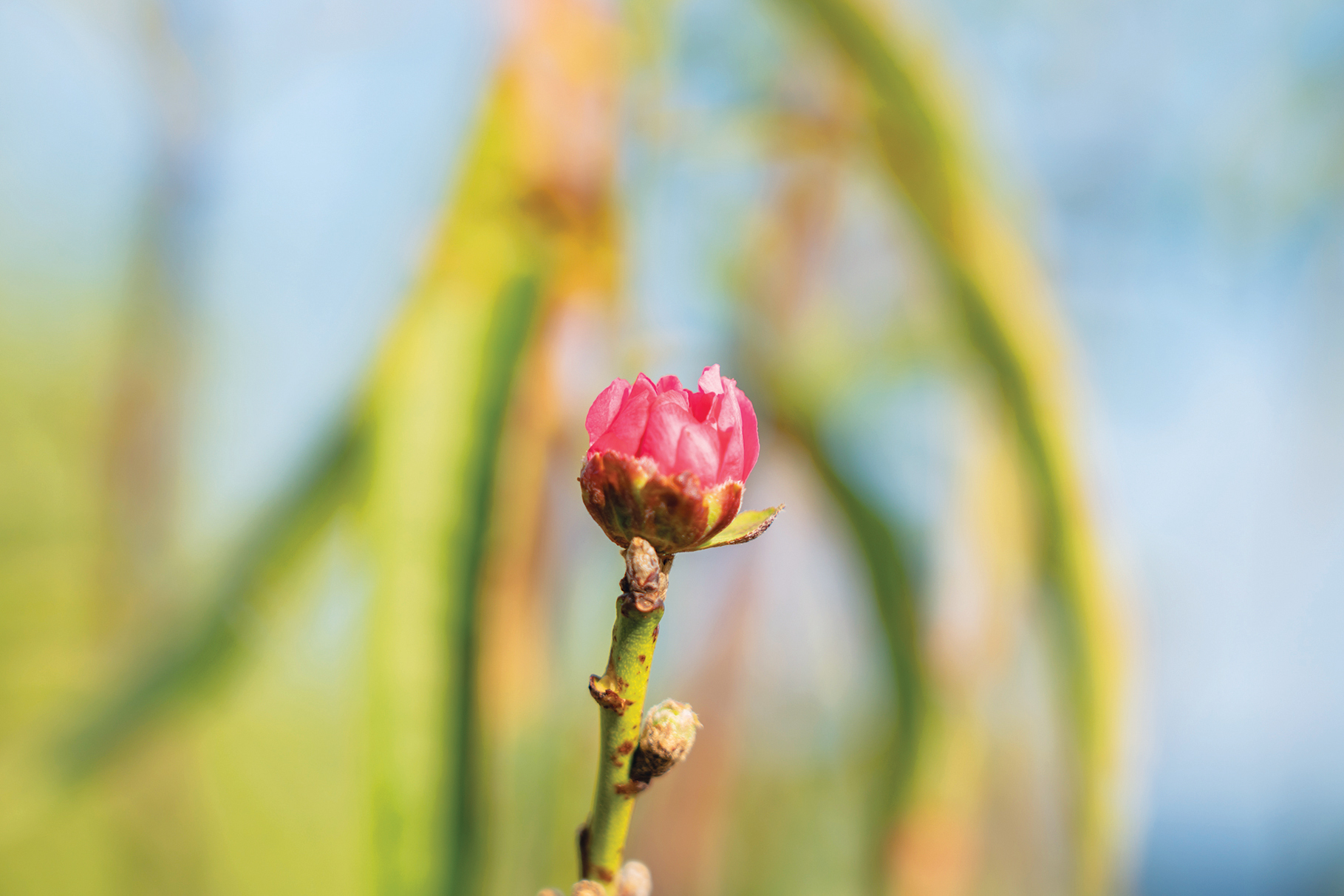
Hidden garden in the city
On the day of our visit, it is raining heavily in Tsuen Wan. Together with Mr. Yau, his wife and his father who founded “Wah Lee Yuen”, we gather and chat at Yau’s family cottage at Fu Yung Shan Sun Tsuen. Mr. Yau’s young son plays with the beloved family dog. Outside, the wind and rain beat on the peach blossom trees. From the window, we see the bustling town of Tsuen Wan. We spend a whole afternoon in this peach blossom garden, hidden right in the middle of the city. It is a memorable experience.
People think peach blossoms are only for Chinese New Year, so farmers only work in autumn and winter. Whenever Mr. Yau and his wife hear such ill-informed comments, they become irritated. “We’re already planning for the next planting at the end of each year!” Mr. Yau says. He adds: “Not only do you need skills, the right soil and climate to grow peach blossom trees, you also need luck. Sometimes, the seedlings looked healthy a few days ago, but then they start losing their buds. That’s devastating! By contrast, when you see the seedlings growing healthily, and they are stable enough to be transplanted into the field, you feel relieved. It’s a bit like taking care of children!”
This feeling of uncertainty bothers the Yau family from time to time. At “Wah Lee Yuen”, a good harvest means having over 200 strong peach blossom trees at year-end. 200 doesn’t seem many, but they are the result of at least three to five years of hard work by the growers.
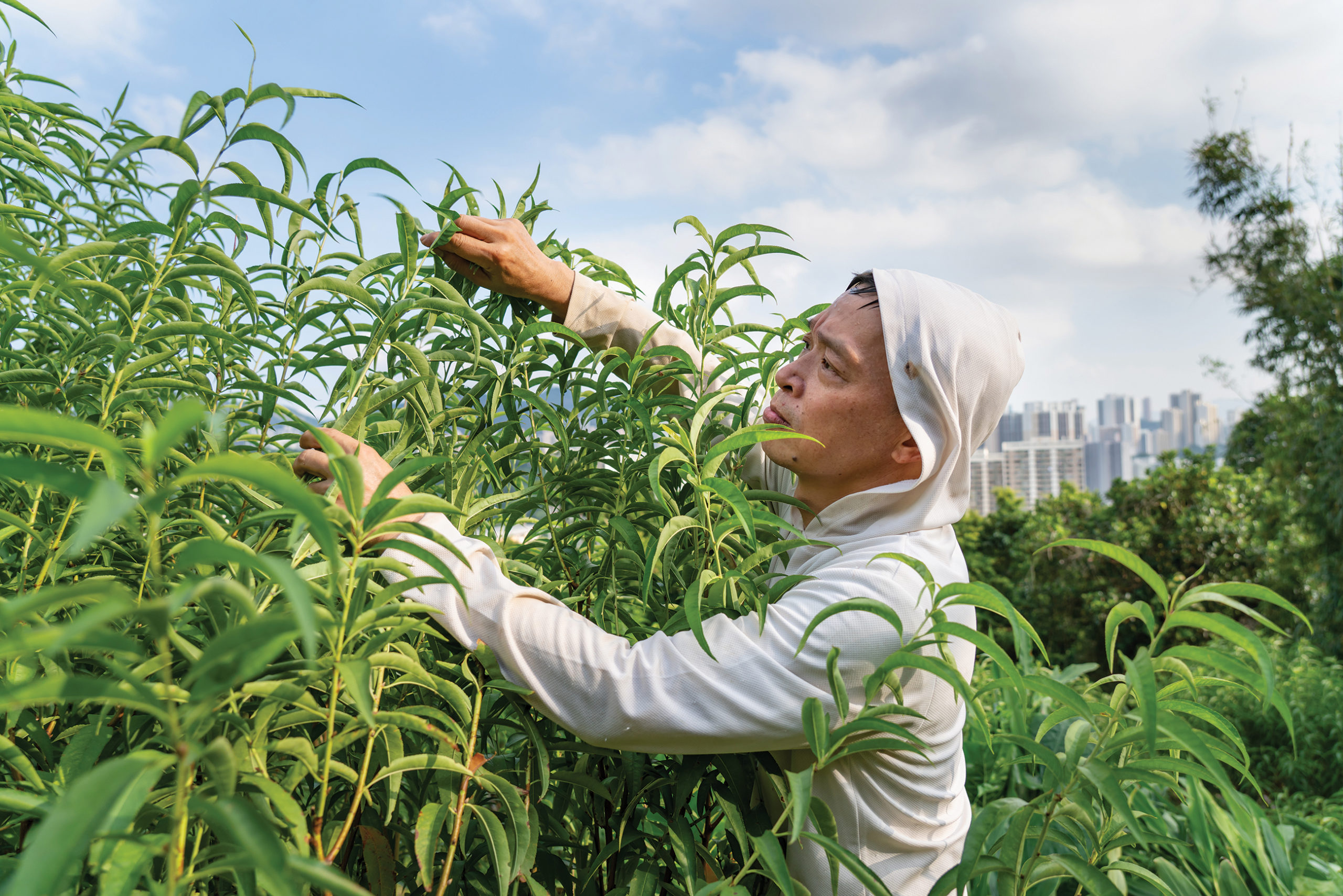
“When you see the seedlings growing healthily, and they are stable enough to be transplanted into the field, you feel relieved. It’s a bit like taking care of children!”
The flower grower’s year
At “Wah Lee Yuen”, each batch of peach blossom trees takes at least three years to grow before it’s ready for sale. Every year-end, while the Yau’s prepare the lush blossoms for their customers’ selection, they also start growing the seedlings for the next year. Every year, they order around 1,000 seedlings of “sweet peach” from the Mainland , then select the best 200 for cultivation. “Growing ornamental peach blossoms for Chinese New Year requires grafting,” continues Mr. Yau. “First, we grow the seedlings for a year, then we graft the buds onto the ‘sweet peach’ branch.” Only in this way can Mr. Yau grow peach blossoms with double flowers, a high-valued species.
“The species we grow are not as simple as the five-petal peach blossoms you see on TV and in cartoons,” joins in Mr. Yau’s wife who can now also talk about peach blossoms like an expert. “At first glance, you can hardly tell how many petals the flowers have, as they give people a sense of vibrancy and abundance.”
For peach blossom trees farmers, the key to a successful harvest is grafting, which takes place every spring and summer, when the peach blossoms are as delicate as little princesses. During this time, the growers wrap the little flowers in plastic bags, and plant them in a field dedicated to young buds, to avoid exposing them to the sun. In the summer, to prevent the young buds being flooded, the growers open the drains before a storm , and surround the buds with protective covers. During our conversation, you can feel the Yau’s sensitivity to the subject of weather. “This summer, the whole months of June and July have been very dry, but there will be a lot of rain in the coming month. The weather is really unusual!”
Besides sheltering the seedlings from wind and rain, it’s equally important to let the seedlings “breathe”. “You have to take off the plastic bags from time to time to check the condition of the buds, and prevent them from getting mouldy.” After two weeks of carefully tending to the seedlings, you generally know if the grafting has been successful. “Observing its growth and branches sprouting out is as satisfying as witnessing the growth of a child,” adds Mr. Yau with a smile.
“The species we grow are not as simple as the five-petal peach blossoms you see on TV and in cartoons. At first glance, you can hardly tell how many petals the flowers have, as they give people a sense of vibrancy and abundance.”
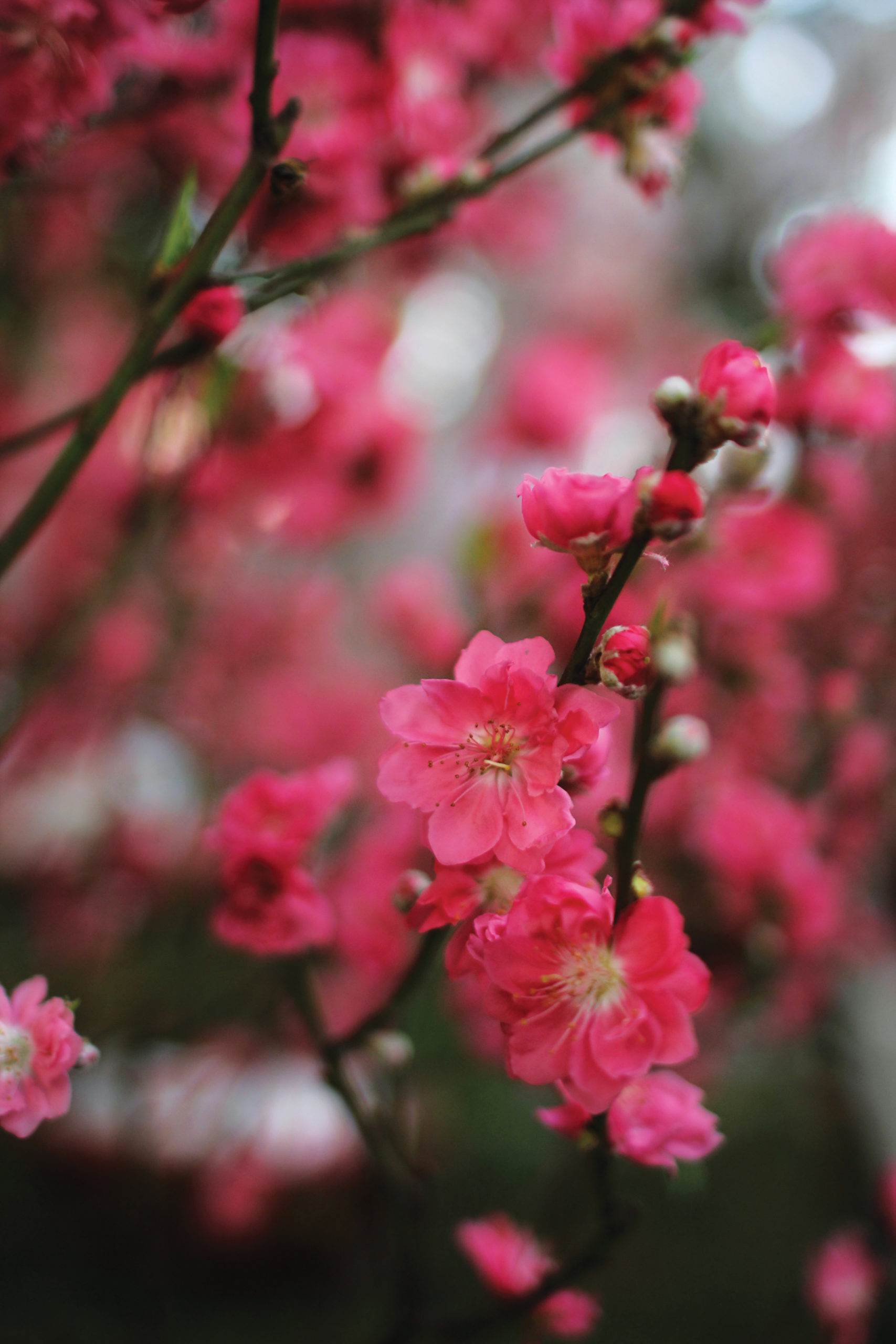
After the seedling stage, there is still a lot of work to be done throughout the year. Weeding, fertilising and turning over the soil are just the basics. To Chinese people, the peach blossoms for Chinese New Year are all about luck; the shape of the flower bunch is important, and requires another set of special skills. The peach blossoms we normally see often have outward- and upward growing branches, which give an impression of fullness and prosperity. Achieving this requires the craftsmanship of the flower growers, not simply the power of nature. “When a branch grows about seven leaves, you have to break it off by hand, allowing two buds to emerge, and changing the growth direction of the flower. You have to keep breaking the branches regularly in this way so that they continue to branch out and grow to their fullest form. If you leave them to grow naturally, the branches just go upwards, looking dull and unattractive.” During autumn and winter, the Yaus add the final touch by decorating the flower bunch. “We tie up the bunch with string, giving it a rounded look. Then, we remove the leaves to stimulate the buds so they bloom just before Chinese New Year.” As we walk through the terraced fields of peach blossom trees at “Wah Lee Yuen”, the Yaus explain their year’s work while fiddling with the leaves and branches.
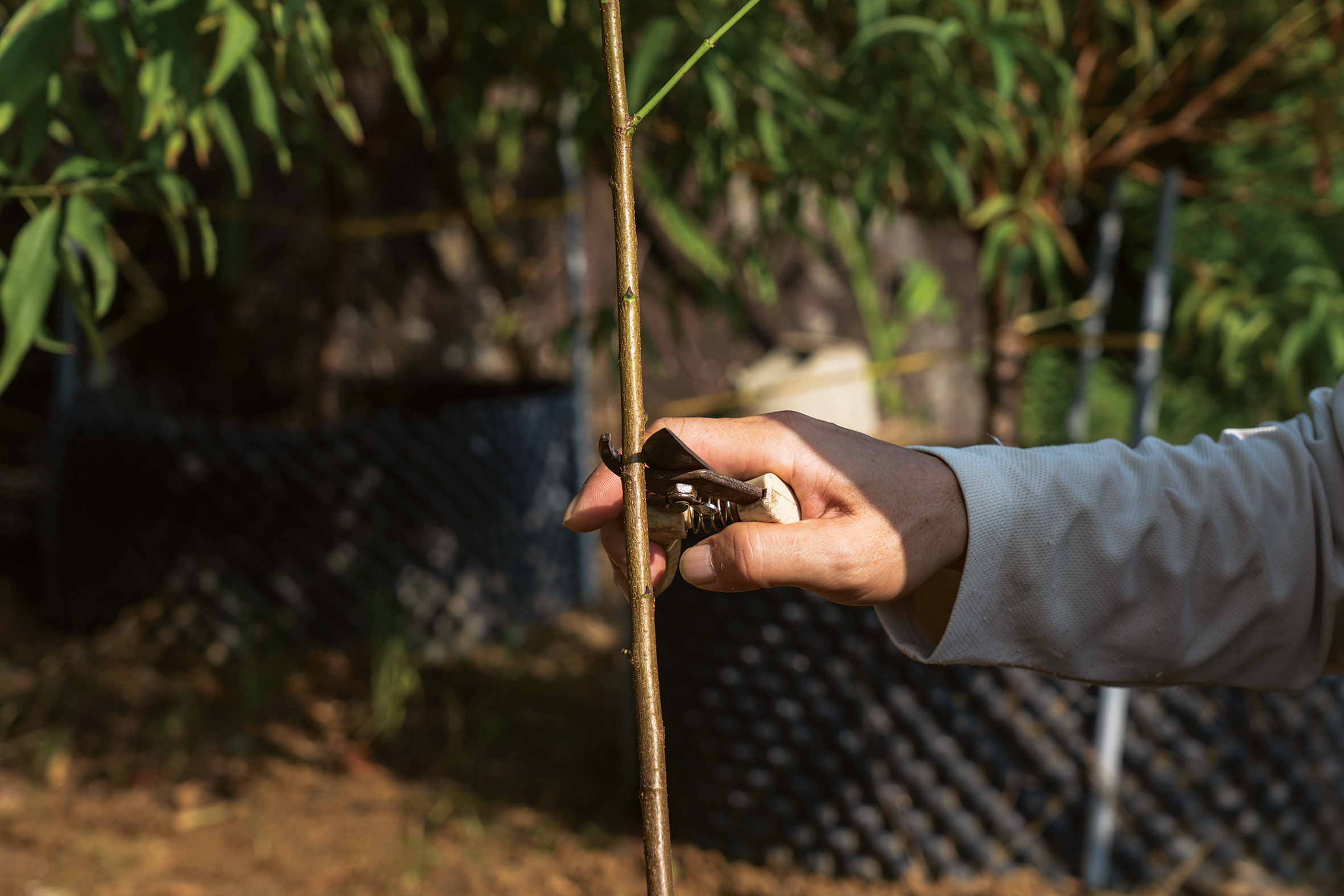
Social history through the eyes of a gardener
For Mr. Yau, the shape of the flower bunch matters; he has learned most of the shaping skills from his father, Old Mr. Yau. When it comes to the art of pruning flowers, Mr. Yau always says: “My dad is even more skillful, you should ask him.” In fact, it was Old Mr. Yau who cultivated the land and started growing at “Wah Lee Yuen” 70 years ago.
A native of Huiyang, Old Mr. Yau started out as a gardener. When Mainland China was at war in the 1950s, he moved to Hong Kong and took his first job at an established restaurant in Shek Tong Tsui. In the old days of Hong Kong, flowers were part of city life: restaurants and Mahjong parlours hired gardeners to take care of their plants for decoration. “The rooftops of restaurants were covered with flowers, and we would grow whatever kind of flowers the owner wanted.” Although Old Mr. Yau has difficulty walking around the flower fields today, he is still in high spirits when he talks about his time as a gardener.
In the 1960s and 1970s, people from all walks of life valued flowers in indoor and outdoor spaces more than they do nowadays. Wealthy families hired experienced gardeners to set up garden plots and floral displays with different patterns and letterings, or to help cultivate bonsais and shape their flowers. “You have to take time shaping the flowers, you can’t do it in a hurry. You have to prune a little at a time, wait overnight until new leaves grow, then continue pruning. During the old days when I worked as a gardener, you had to live in the employer’s house and prune the flowers regularly every day to achieve the perfect look,” Old Mr. Yau says with pride.
In days gone by, even though the general public were not enjoying an elaborate lifestyle, they often bought flowers to decorate their homes: Chinese New Year citrus plant, chrysanthemums and peach blossoms in winter, and Lucky Bamboo and Ginger Lily in spring and summer. “In the old days, people in Hong Kong regarded growing flowers as a kind of entertainment and amusement, but also with a practical purpose. Some households had a lot of family members living in a small place, so in summer it could get smelly and sweaty! If people wanted to freshen the air, they would grow or buy flowers. But nowadays, people are used to instant entertainment such as watching TV and playing video games, and they can’t stand the slow pace of growing flowers. It’s not even necessary to keep the smell away by growing flowers, as air conditioning is available everywhere, and it’s even more convenient to use an air purifier.” Mr. Yau says there was a high demand for flowers in the past, so “Wah Lee Yuen” used to grow different kinds of flowers and even ran a small stall in the market selling home-grown flowers throughout the year. “I remember when I was a kid, I would go to the stall after school to help my mother sell flowers.”
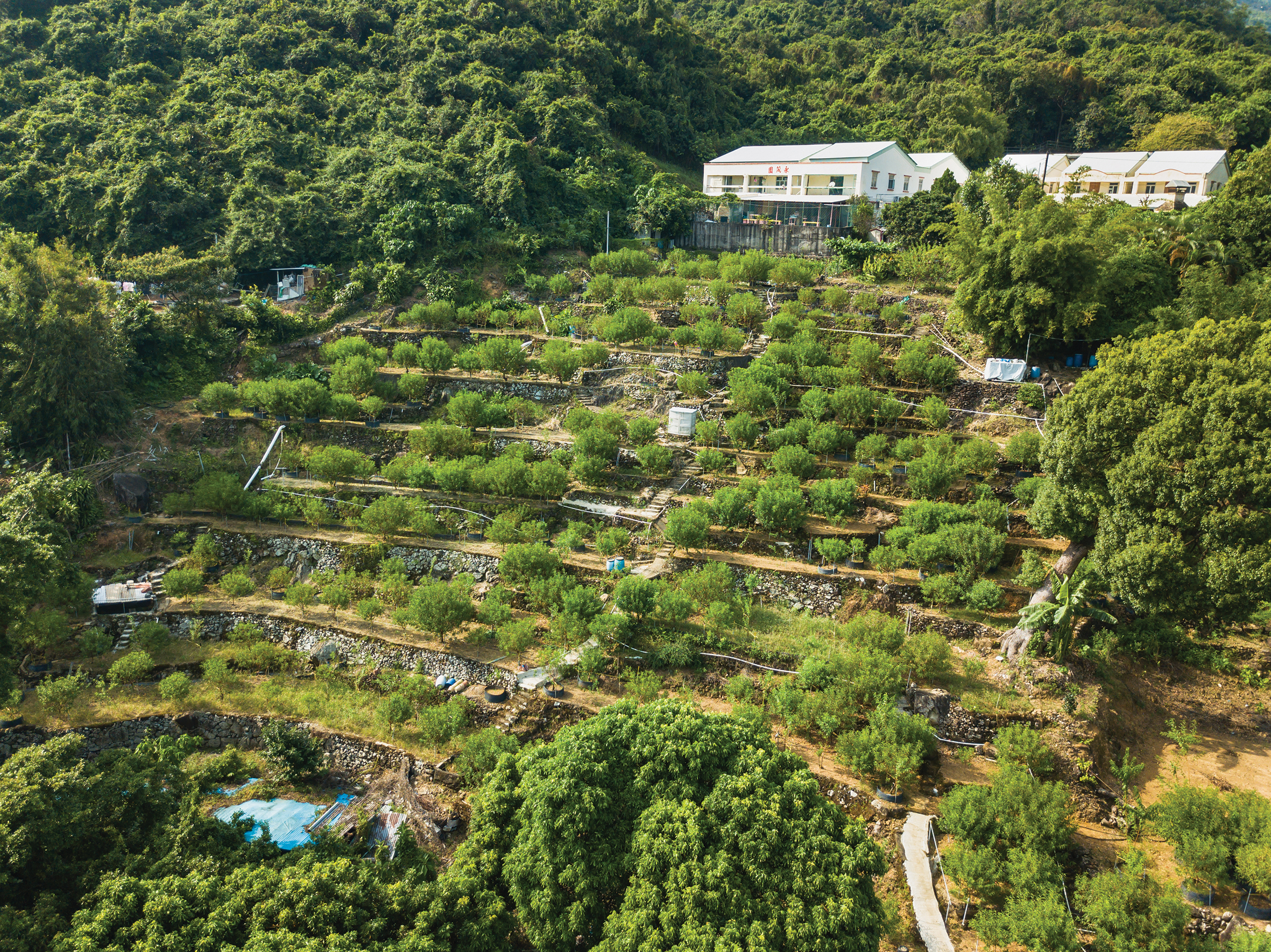
“In the old days, people in Hong Kong regarded growing flowers as a kind of entertainment and amusement, but also with a practical purpose. Some households had a lot of family members living in a small place, so in summer it could get smelly and sweaty! If people wanted to freshen the air, they would grow or buy flowers.”
Scrutinising peach blossoms becomes a habit
Mr. Yau is the youngest son in a family of eight siblings. In 2015, Old Mr. Yau fell down unexpectedly, so Mr. Yau, who used to work in the garment industry, took over the business. “In fact, we had considered closing down the garden, he admits. However, all of Mr. Yau’s childhood memories are rooted in “Wah Lee Yeun”, so he couldn’t let it go. “When I was little, we grew flowers and raised chickens and pigs. This field was very lively.” When Mr. Yau was little, he loved to play with his siblings in the mountains after school, rather than playing football. “We used to run around the mountain side after school, picking and eating wild fruit, such as Rose Myrtle and Passion Fruit. Sometimes we even walked from “Wah Lee Yuen” to Chuen Lung in Tai Mo Shan; it was such fun! I have all my childhood memories here, so I really didn’t want to see this place go to waste and so I decided to take it over.” Besides receiving guidance from his father, Mr. Yau also read a lot of books to develop his knowledge of growing peach blossoms. Today, peach blossoms are in his blood. “In recent years, when I watch martial arts dramas, I’m not focusing on the plot, but the scenes with peach blossoms. As I watch, I wonder: ‘Are those real flowers or fake ones? Is this plum flower or peach blossom? How many petals does it have? Is it the same species as the one we grow?” Mr. Yau says with a smile. Growing up in a flower garden, and now being the owner of a peach blossom tree garden, observing and categorising peach blossoms has become a habit.
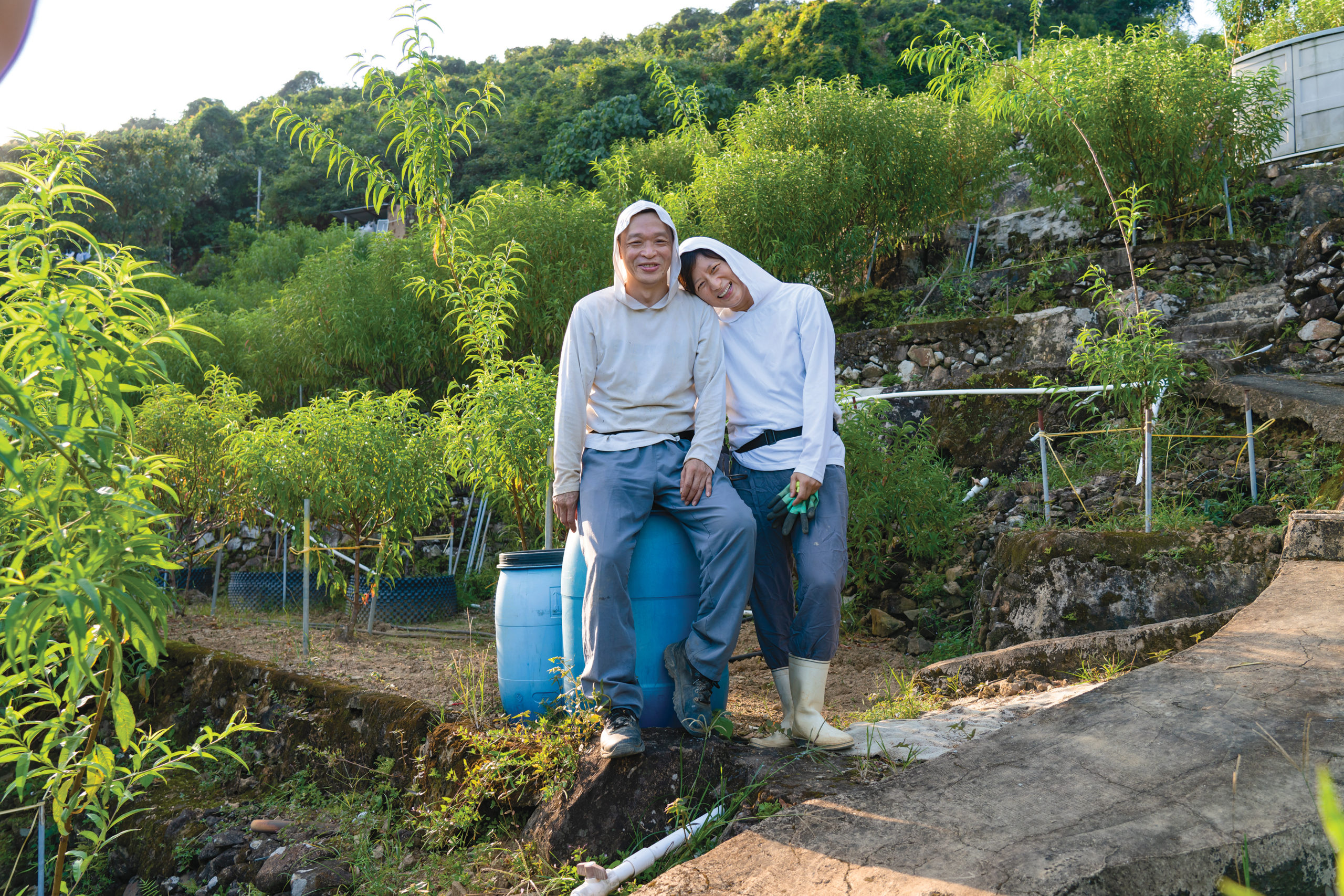
Hip Yee Hing
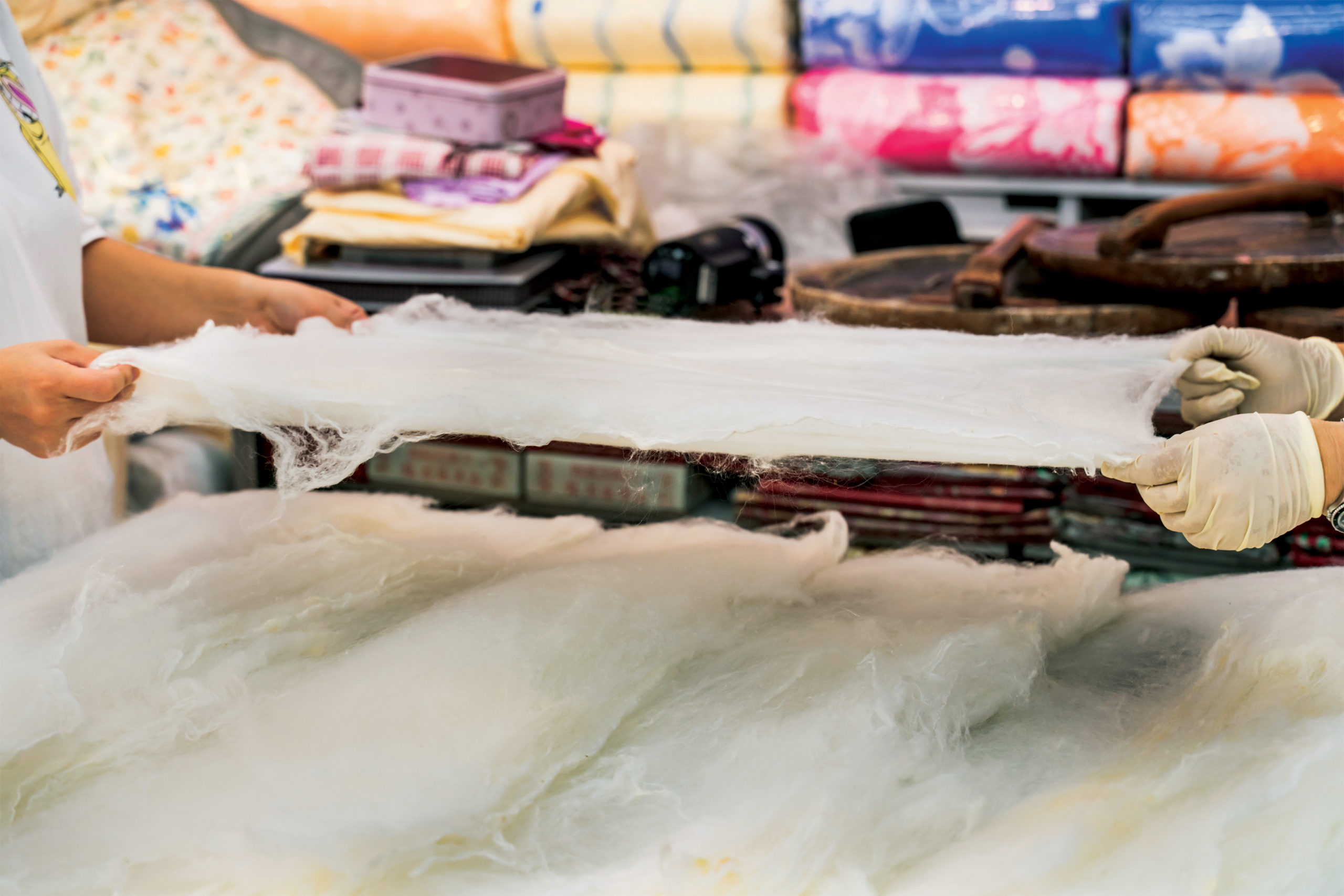
Winter warmth in Hip Yee Hing
Besides flower farmers, old-fashioned bedding shops are another type of traditional business that requires “watching the weather”. “Hip Yee Hing” in Shek Kip Mei is one of the few remaining shops in Hong Kong still selling hand-made silk quilts. You can predict the weather for the coming week just by looking at the sales performance of “Hip Yee Hing”. “If the Hong Kong Observatory forecasts that the weather is going to get colder in the coming day, business may only go up a bit, but if it says it’s going to stay cold for the following week, then it’s a great sign, and sales will be strong as people in Shek Kip Mei will queue up to buy quilts,” Lam Mi-sin (Fourth Aunt) explains.
“Hip Yee Hing” was founded in 1967 by the late Mr. Lam. Today, it has been taken over by his daughter, Fourth Aunt. With its hand-made silk quilts, it has become a famous and long-established name in Hong Kong that has featured on many travel websites and television programmes. The Shek Kip Mei community, as well as the climate in Hong Kong, have changed a lot over the past 50 years. “Hip Yee Hing” has also transformed over the years, from specialising in “opera flowers” (hairpins and hair accessories for the actors and actresses of Cantonese opera) and wedding accessories in its early days, to mainly selling bedding today.
After Mrs. Lam, Fourth Aunt’s mother, passed away in 2003, Fourth Aunt couldn’t bear to see her parents’ hard work thrown to the winds, so she took over the business and has been running it for nearly 20 years now. On the day of our visit, Fourth Aunt shares with us the story of the silk quilt industry and her personal memories of Shek Kip Mei.
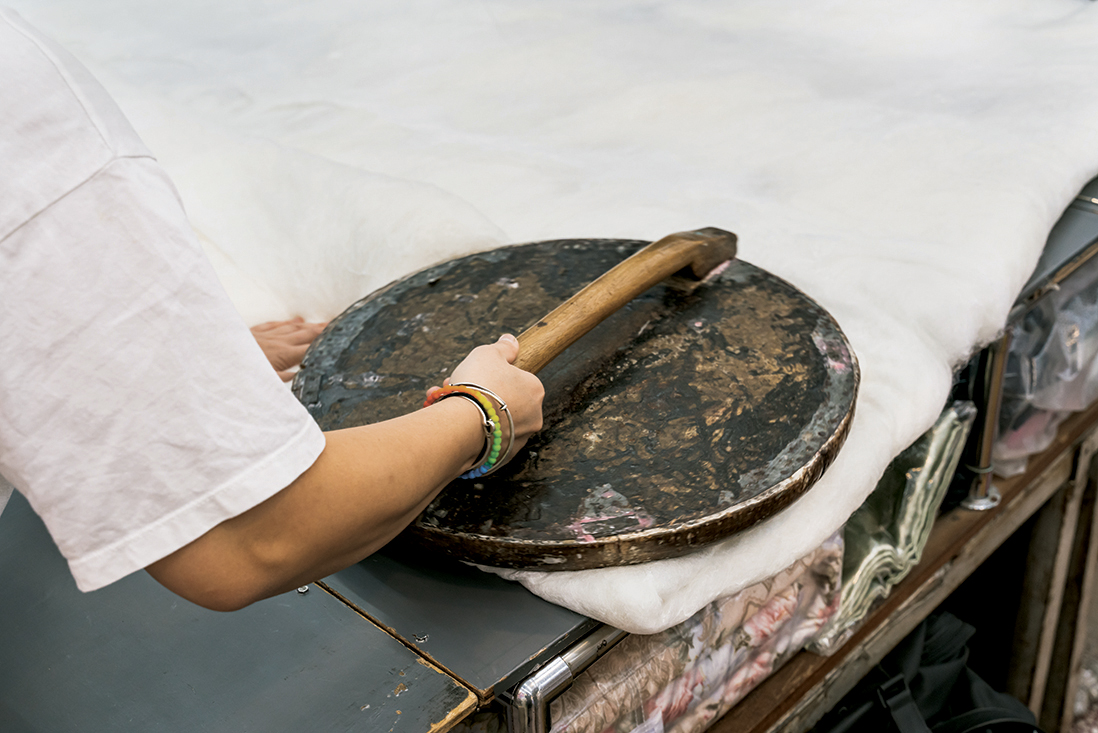

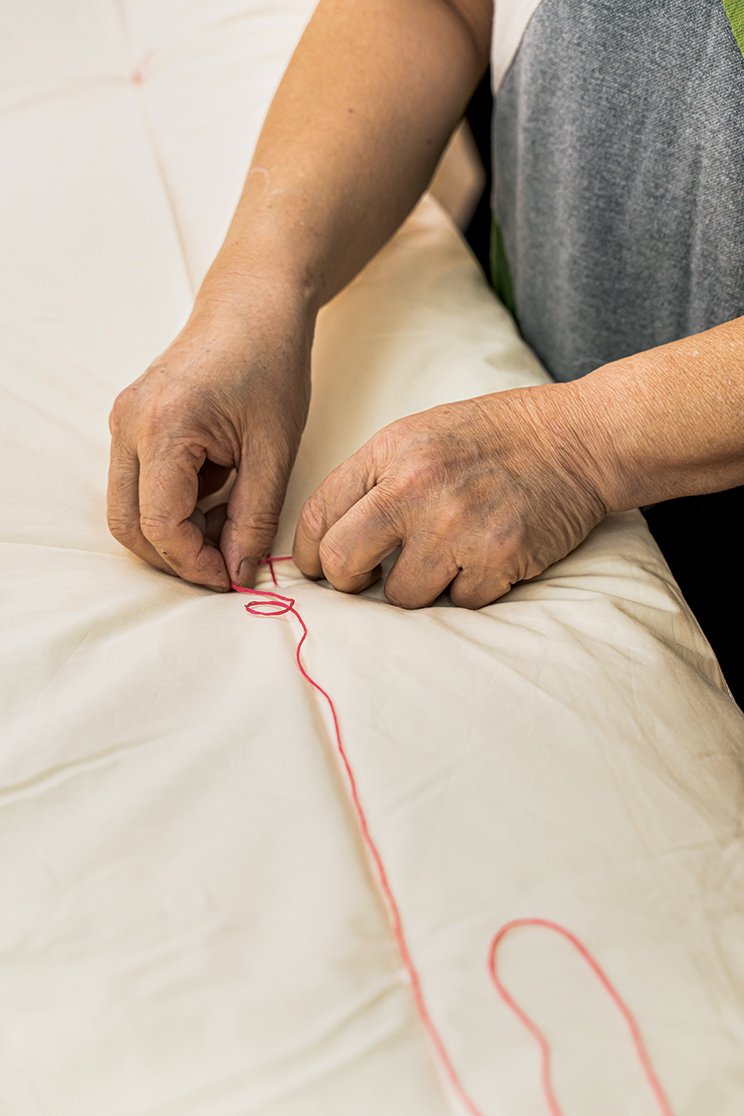
The silk industry
Silk quilt is made from natural silk, which is ideal for all seasons: “In winter, it is light but warm. In summer, it can be used as a summer quilt, which doesn’t make you feel too hot and sweaty. This is what makes silk quilts so much better than duvets or man-made fibre quilts. Therefore, silk quilts are not cheap, averaging HKD $2,000 to $3,000 each,” Fourth Aunt explains. The silk quilts at “Hip Yee Hing” are made of high-quality “pig-stomach-like silk” from Panyu (the silk is woven into small bags, which look like pig stomachs). “We have tried using silks from other places, but they are not as soft. After all, you get what you pay for.”
To this day, Fourth Aunt still works at the shop and makes the quilts herself, together with her workmate and niece, Bean. The first step in quilt making is to place the silk piece by piece on the knee, to form multiple layers. Then they stretch the layers of silk: this step is very much about balance of strength, as too much force breaks the silk layers, while too little does not soften them enough. The most crucial step is to spread the loosened layers of silk on a specially made base board, then use a grinding tool to spin the silk layers back and forth, pressing and fusing them together. The final step is sewing the quilt bag together with needle and thread. The whole process takes nearly 3 hours. “Although silk is precious, that doesn’t mean the more the better. For a standard silk quilt, four market catties (equivalent to 2 kg) of silk is just right. There was one time when a customer insisted that I use five market catties of silk to make a quilt, but then she came back the next day and said it was too hot,” Fourth Aunt laughs. The silk quilts made by “Hip Yee Hing” usually last for 30 to 40 years. “Many first-time customers find the quilts too expensive, but after decades of use, they realise that it is the best value winter essential.”

“But times are changing. Today, “Hip Yee Hing” no longer sells wedding items, but simply quilts, bed sheets, bamboo mats and other bedding.”
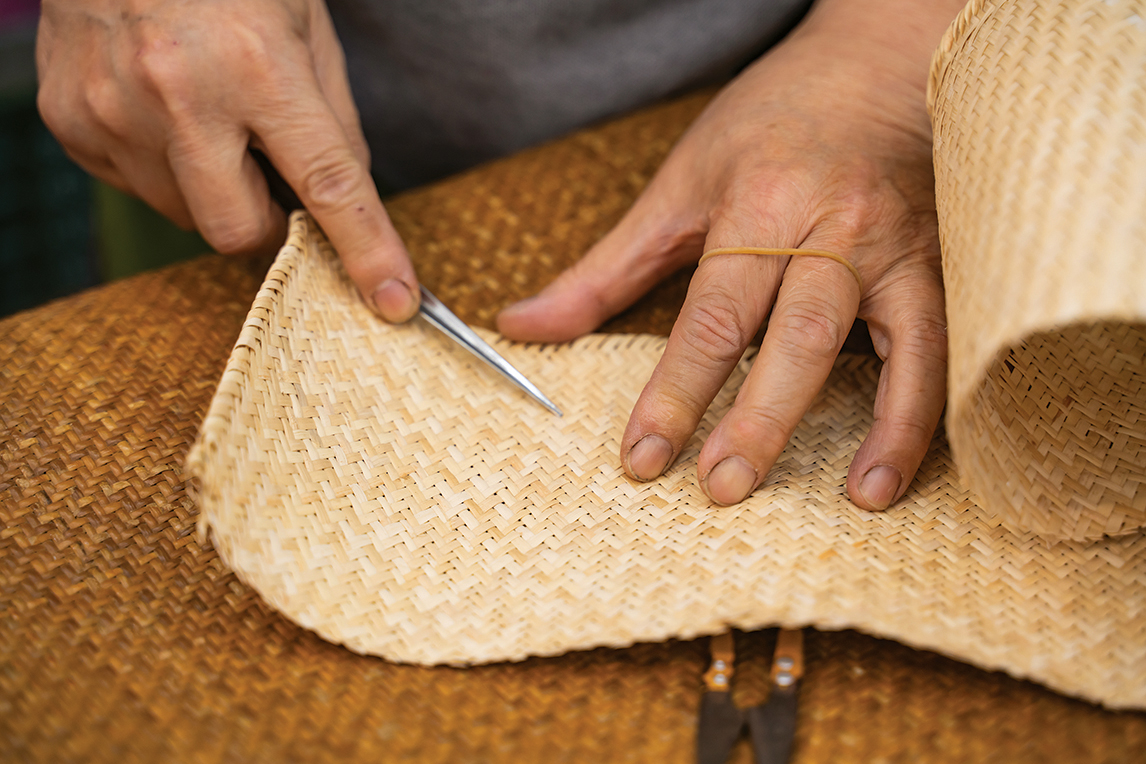
Supervisor turned apprentice
Fourth Aunt learned the art of silk quilt making in her childhood. In the 1970s, when there was not enough space in the shop to make quilts, the family outsourced the orders to quilt masters. Fourth Aunt would carry several market catties of precious silk from Shek Kip Mei to the tenement buildings on Yee Kuk Street and Hai Tan Street in Sham Shui Po, and hand them over to quilt masters for processing.
In those days, it was common practice for quilt masters to swap expensive silk for cheap cotton. “Those masters also took orders from other customers, so they would take the silk, and mix in cheap cotton to make quilts for sale (this kind of silk and cheap cotton quilt could be sold at more affordable prices). Quilt masters had many ways of cheating; sometimes they turned their backs and pretended they were making a quilt, but in fact they were mixing in cheap cotton with the silk. When you picked up the quilt, the bag had already been sewn up, so it was difficult to tell the silk inside had been swapped for cotton.” This is why silk quilt merchants would always arrange for their “own people” to deliver the silk to the quilt-making workshops, then ask them to stay to supervise the quilt-making process. Since Fourth Aunt was so little, those masters paid no attention to this young supervisor. “They would kick the silk under the table while making the quilts. But I was too little at that time, and the masters did not take me seriously at all,” Fourth Aunt laughs.
Although Fourth Aunt failed to stop the masters from swapping the silk, “I learned how to make a quilt out of a piece of silk while ‘supervising’ the masters,” she says. “When I had nothing to do, I would help the masters loosen the silk, so eventually I acquired the skills of quilting.” Nowadays, “Hip Yee Hing” sells a few dozen hand-made quilts a year. To ensure they have quilts to use in the winter, some customers place orders in summer, then pick them up when winter arrives. Although “Hip Yee Hing” is known for its silk quilts, Fourth Aunt admits their business cannot be compared with the old days. “Our business was best in 1997 when there was mass emigration from Hong Kong. People liked to order a silk quilt and take it with them. But nowadays, with so many alternatives and only a few truly cold days in winter, people are reluctant to spend HKD $3,000 on a single quilt.”
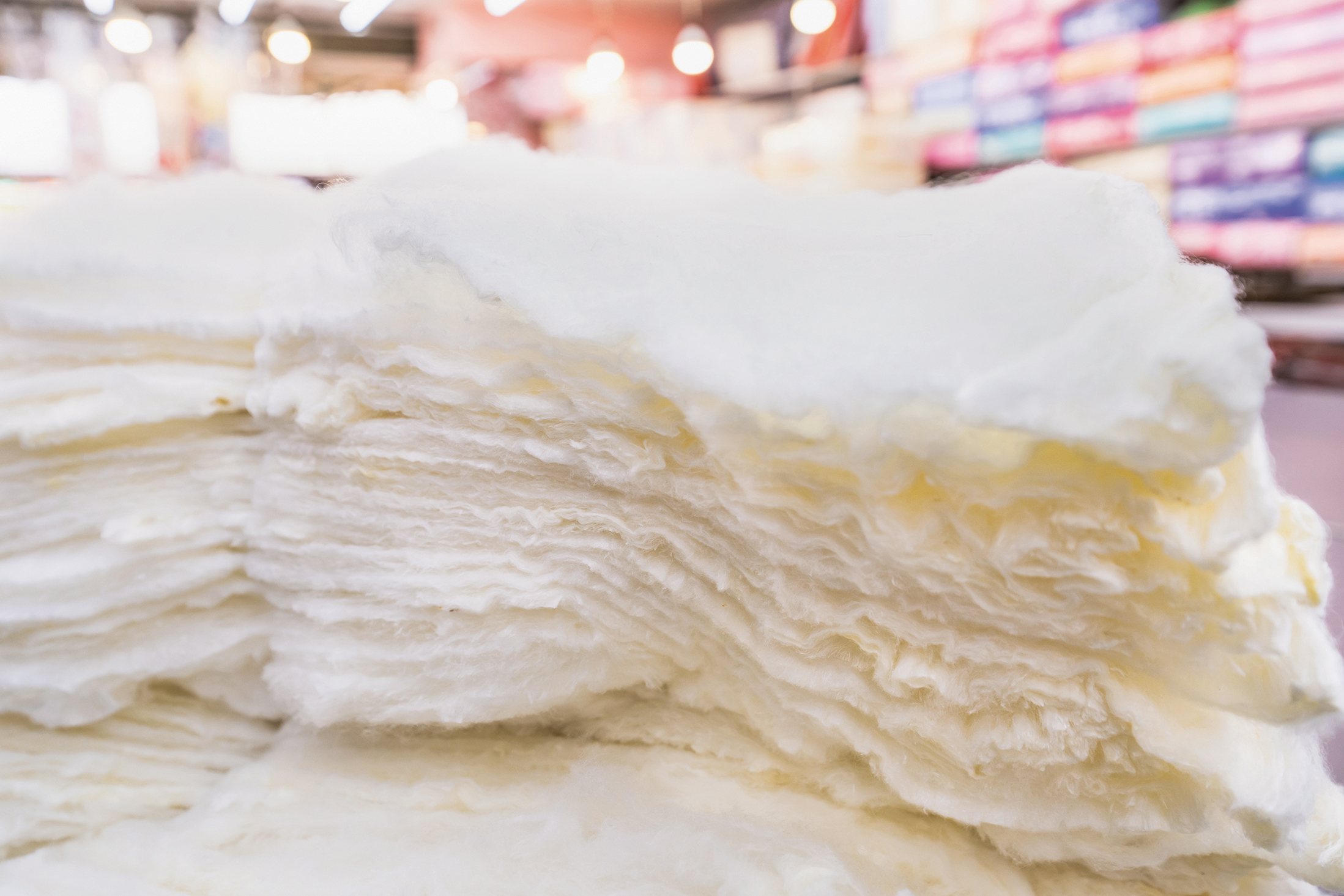
“The first step in quilt making is to place the silk piece by piece on the knee, to form multiple layers. Then they stretch the layers of silk.”
From dowry to silk quilt
“Hip Yee Hing” mainly sold wedding items when it was first established, with bedding and quilts being a lesser priority. The founder, Mr. Lam, was a Cantonese who went to Shanghai to learn the craft of making “opera flowers” when he was young. The same technique can be applied to making wedding corsages for the groom and groomsmen. Eventually Mr. Lam also started to sell other wedding-related items such as bed covers. “In the early days, my father made a lot of ‘opera flowers’. Even famous actors and actresses like Mr. Sun Ma Si Tsang and the Hung Sin Nui came to our ‘seven-storey blocks’ (the shop was originally located in the seven-storey Shek Kip Mei resettlement blocks) to buy headdresses in our 100-plus-foot unit!”
Later, as the Mainland re-formed and opened up, people tended to order cheaper “opera flowers” from there, so “Hip Yee Hing” switched to wedding and bedding products. “Traditionally, the bridegroom’s family needs to buy corsages and wedding signature cloth, while the bride’s family have to prepare the dowry, pillows, quilts, bed sheets and even rent Chinese wedding gowns. We would provide all these to our customers.” Traditionally, there are off-seasons and peak seasons for the wedding business: “According to the Lunar calendar, Ching Ming Festival falls in April, a ‘June Bride’ is considered unlucky, the Hungry Ghost Festival is in July, and Chung Yeung Festival is in September — all of these months are considered inappropriate for marriage in Chinese tradition. So our peak season has always been at the end of the year, during the winter.”
But times are changing. Today, “Hip Yee Hing” no longer sells wedding items, but simply quilts, bed sheets, bamboo mats and other bedding. “In the past 20 years, modern wedding planners have been providing a one-stop service. People can rent Chinese and Western-style wedding attire, and clothes for their parents and bridesmaids, in a single shop. We didn’t have enough variety of products, so naturally we were less competitive. Sometimes, customers requested to cancel their orders after placing deposits to rent wedding dresses. They realised there were more choices at cheaper prices in wedding planners’ shops.” Besides, a wedding is all about good luck in Chinese tradition, so the salesperson must be very eloquent and good at saying the right things to customers. But Fourth Aunt is an honest person; she scratches her head and says, “I’m very direct. It is awkward for me to spend the whole hour speaking words of congratulation and blessings. That’s why we stopped renting out wedding attire and other wedding-related items in mid-2000. I don’t particularly feel it a loss!”
“They are for our neighbours to gather when they pass by...it’s nice to get together for a chat, and there’s room in the shop, so why not?”

Community bond in Shek Kip Mei
For Fourth Aunt, the reason for continuing to run “Hip Yee Hing” is not only to keep her father’s hard-earned business alive, but also to preserve the community bond in Shek Kip Mei. Fourth Aunt’s family lived through the Shek Kip Mei fire and subsequently moved into the resettlement block, and later into the public housing estate on its completion. Fourth Aunt can’t stop talking as she looks back on her childhood: “In the old days, Shek Kip Mei was a place where there were many gangsters. When I was a kid, I knew my neighbour's family were all gangsters. I admired them so much, they seemed so cool! I intentionally spent time with them and played with them, hoping to draw their attention. But even gangsters value morality. As neighbours, they never let me join as they were afraid of upsetting my parents,” she laughs.
A few chairs are placed in a corner of the shop, which are not for sale and are totally unrelated to the rest of the products on display. “They are for our neighbours to gather when they pass by,” explains Fourth Aunt. “Some of them grew up with me, and even used to play Mahjong with my mother! Most of them come here not for shopping, but to talk about family matters, like their daughters or sons getting married, the lives of our elderly friends, etcetera. It’s nice to get together for a chat, and there’s room in the shop, so why not?” In fact, Fourth Aunt is very affectionate to her workmates. During the pandemic, an old master with whom Fourth Aunt used to work for many years, unfortunately died of the illness. “I was so close to this master that I would even help repair his household items. After he passed away, I volunteered to help take care of his affairs.” At “Hip Yee Hing”, warmth comes from more than just handmade silk quilts.

